 MyDogBreeds
MyDogBreeds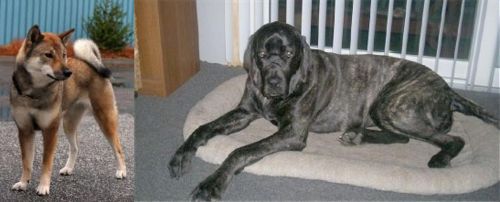 Shikoku is originated from Japan but Giant Maso Mastiff is originated from Germany. Shikoku may grow 43 cm / 16 inches shorter than Giant Maso Mastiff. Shikoku may weigh 37 kg / 81 pounds lesser than Giant Maso Mastiff. Shikoku may live 3 years more than Giant Maso Mastiff. Shikoku may have less litter size than Giant Maso Mastiff. Shikoku requires Moderate maintenance. But Giant Maso Mastiff requires Low maintenance
Shikoku is originated from Japan but Giant Maso Mastiff is originated from Germany. Shikoku may grow 43 cm / 16 inches shorter than Giant Maso Mastiff. Shikoku may weigh 37 kg / 81 pounds lesser than Giant Maso Mastiff. Shikoku may live 3 years more than Giant Maso Mastiff. Shikoku may have less litter size than Giant Maso Mastiff. Shikoku requires Moderate maintenance. But Giant Maso Mastiff requires Low maintenance
 The Shikoku is from the Shikoku Island in Japan and they are very much like the Japanese Shiba Inu. There are six native Japanese dog breeds and the Shikoku is medium sized and sits in between the smaller Shiba Inu and the very large Akita Inu. All of the Japanese native breeds are members of the Spitz family. The Japanese have sorted their six breeds into 3 categories by size. Being medium size, the Shikoku is a member of the Shika-inus group. Others in this group are the Ainu Ken, the Kai Ken and the Kishu Inu. There are small differences between the three dogs in the Shika-inus group.
The Shikoku is from the Shikoku Island in Japan and they are very much like the Japanese Shiba Inu. There are six native Japanese dog breeds and the Shikoku is medium sized and sits in between the smaller Shiba Inu and the very large Akita Inu. All of the Japanese native breeds are members of the Spitz family. The Japanese have sorted their six breeds into 3 categories by size. Being medium size, the Shikoku is a member of the Shika-inus group. Others in this group are the Ainu Ken, the Kai Ken and the Kishu Inu. There are small differences between the three dogs in the Shika-inus group.
The Shikoku was bred to be a hunting dog in Kochi Prefecture to hunt boar and deer. Other names for the breed include Kochi-ken and Kishu dog or boar hound. This dog is considered to be the purest of the Japanese native dogs or Nihoken. They are today very , very rare. There are very few outsides of Japan, but some in North America are attempting to save the breed.
The are od Kochi Prefecture is a mountainous region with rough terrain that anyone outside of the area would have a hard time accessing. That is why the Shikoku is considered to be so pure as they were pretty well isolated in the mountains. The breeders were also isolated by the mountains and there was very little interbreeding. Although breeding the same dog, these different groups developed different lines of the Shikoku.
Documentation tells us that the number of originals lines was just two and these were the Western and Eastern Shikoku. The Western dog was known as the Mount Ishizuchi Shikoku and the Eastern as the Mount Tsurugi Shikoku. Within these two lines of Shikoku there are additional strains.
Within the Eastern line there is the Tokushima (lya) and the Koci-Aki strains. Within the Western line there is the Hata Uwahara, the Ehime-ken Shuso-gun and the Honkawa. Among these lines and strains, there are different coats and different colors; some heavier and some taller, but all figure into the development of the breed.
Finally, in the Showa Era the Japanese established the Dog Protective League and they began collecting the native dogs from around the country. They protected them so that the breed will go on. The Shikoku is today recognized as Foundation Stock by the AKC and it is fully recognized by the Japan Kennel Club, the Canadian Hound Club and the Shikoku has been declared a living Japanese “natural monument”.
Two bloodlines became the way the Shikoku were know after the war – the Honkawa and the Hata lines The Honkawa line were the descendants of the Choshun-go and the Hata line were the descendants of the Matsukaze-go. They bred the lines separately until 1955, when they mixed them to make the breed stronger. They are no longer considered separate in any way.
Because they are such primitive dogs, the Shikoku are good watch dogs and quite reserved with strangers. They need a lot of socialization to be a family pet but once they are, they make great companions. Intelligent, quick to learn and eager to please. Of the two lines of Shikoku dogs from the Western strains, the current Shikoku owes much of its current development to the Honkawa and Hata strains.
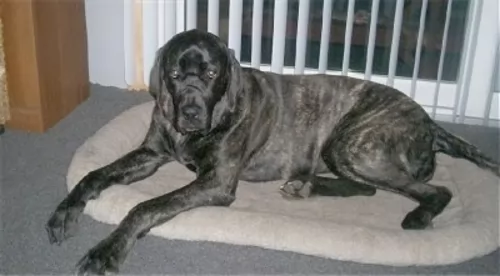 The Giant Maso Mastiff is a fairly new dog breed so you aren’t going to find much history on him.
The Giant Maso Mastiff is a fairly new dog breed so you aren’t going to find much history on him.
The breed was only started in 2001 so as to create a mastiff dog that would have fewer health problems and therefore have the chance to live longer. The Giant Maso came about because of a mix between the Old English Mastiff and the Cane Corso Italiano.
As stated, breeding began in 2001 and the dog has inherited intelligence and protective instincts from both these dogs.
 Today’s Shikoku is a medium sized breed with a Spitz like body – square with a head that is wedge shaped. The ears are pointed, and the tail is curved and feathered. They have arched toes and hard pads with dark, hard nails.
Today’s Shikoku is a medium sized breed with a Spitz like body – square with a head that is wedge shaped. The ears are pointed, and the tail is curved and feathered. They have arched toes and hard pads with dark, hard nails.
The two lines of the Shikoku are slightly different in built and look. The Honkawa strain is slender and athletic; agile and single coated. They have dark eyes and most of them are black and tan.
On the other hand, the Hata strain is much heavier boned, with the front more muscular than the rear. They have small ears, a wide skull and a strong undercoat. His eyes are shaped differently than the Honkawa. Their coats are also mostly red and tan.
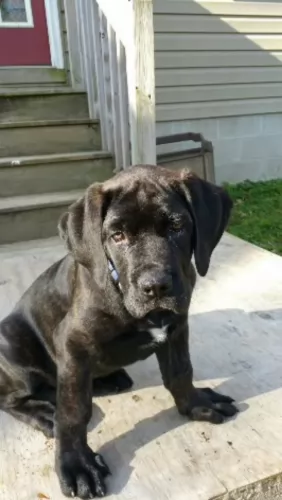 The Giant Maso Mastiff is a large dog breed and can stand at between 67 to 70cm in height and weigh 60 to 90-kg.
The Giant Maso Mastiff is a large dog breed and can stand at between 67 to 70cm in height and weigh 60 to 90-kg.
He has a big square head with medium sized floppy ears and thick neck covered with loose skin. Muscular, he is a deep chested dog with powerful legs and long tail. The fur of the dog is short and sleek and can be a number of colors such as fawn, an apricot color, gray and black as well as brindle.
Intelligent, protective, self-confident, balanced and calm, the Giant Maso Mastiff may be quite an imposing looking dog but he is gentle-natured towards his family.
The large dog loves to please and receive praise from his human family. He is the perfect friend, getting on well with children in the home as well as with other dogs. Training and socialization is easy for this dog and it is important that he is trained if you want him to be an obedient pet.
He is gentle, intelligent, protective – simply known as a gentle giant, being calm, steady and amicable. This breed loves to please and needs lots of companionship from his human family, loving just to lie close by to them.
He isn’t a particularly active dog, but will still need to join you on a walk every day. It is why the Maso Mastiff can live in the city or in the countryside, because not being an overly active dog, he doesn’t need a large garden.
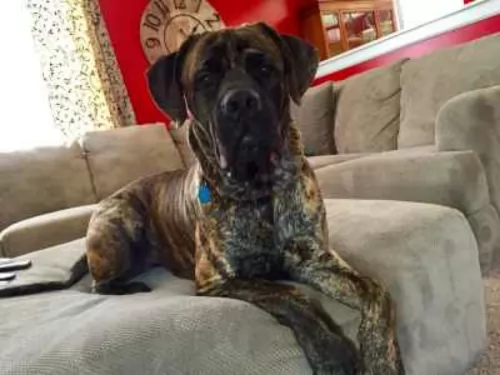 Your Giant Maso Mastiff is such a gentle giant of a dog. He is well behaved and gentle so that it almost seems unnecessary to have him trained and socialized and yet doing so will make him even more amicable.
Your Giant Maso Mastiff is such a gentle giant of a dog. He is well behaved and gentle so that it almost seems unnecessary to have him trained and socialized and yet doing so will make him even more amicable.
Calm and gentle he makes the perfect pet for families where there are children as well as elderly people. He is quite frankly everyone’s friend, being a loving family pet. If you’re a family more into indoor games and TV watching than an outdoor, sporty kind of family, the Giant Maso Mastiff will suit you.
He will love to settle down and watch TV with you. He isn’t particularly active, although he will certainly need a walk every day.
Those who have owned a Giant Maso Mastiff will tell you that this is an excellent family pet, making a wonderful companion dog.
 Being isolated as they were, the Shikoku was a fairly healthy breed, no genetic testing has been done. Despite this they suffer a few of the same potential issues as other breeds their size.
Being isolated as they were, the Shikoku was a fairly healthy breed, no genetic testing has been done. Despite this they suffer a few of the same potential issues as other breeds their size.
Otherwise this is an agile and hardy breed with no known congenital health issues.
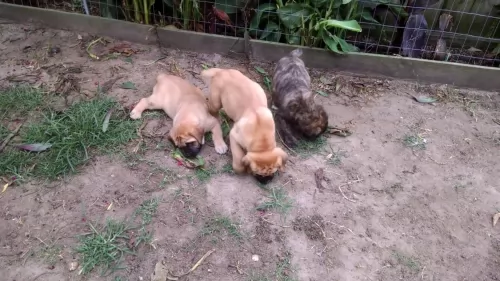 There has always been the concern with joint disorders in large breed dogs. Both hip- and elbow dysplasia can occur with your Giant Maso Mastiff, more so if you overfeed him as a puppy and he grows too fast.
There has always been the concern with joint disorders in large breed dogs. Both hip- and elbow dysplasia can occur with your Giant Maso Mastiff, more so if you overfeed him as a puppy and he grows too fast.
With hip dysplasia, the long bone of the leg forms incorrectly. This can lead to pain and lameness with your pet.
Also check out bloat. This is a serious illness when the stomach fills with air and can twist. Gastric Dilatation-Volvolvus, is an emergency situation then which is found more often in large, deep-chested dog breeds.
If you see your dog with a bloated stomach and acting in a strange, lethargic way, get him to the vet immediately as bloat can be life threatening.
 Feeding the puppy Be careful with feeding the puppy and adult as the breed is known to have a tendency toward obesity. Fresh food is better as it is what the breed has been used to, but a high quality puppy kibble is acceptable. Feed three times per day.
Feeding the puppy Be careful with feeding the puppy and adult as the breed is known to have a tendency toward obesity. Fresh food is better as it is what the breed has been used to, but a high quality puppy kibble is acceptable. Feed three times per day.
2.Feeding the adult He is a high energy dog so feed a high energy food designed for a medium sized dog. Feed in two meals each day.
4. Games and Exercises You will need a fenced yard for this breed and time to play with them. If not, you would need time to walk her more than once a day. They love to play indoors as well, chasing balls, learning new things. The breed make great companions for hiking, swimming, play frisbee or catch outside. They do well at agility, rally, obedience and flyball.
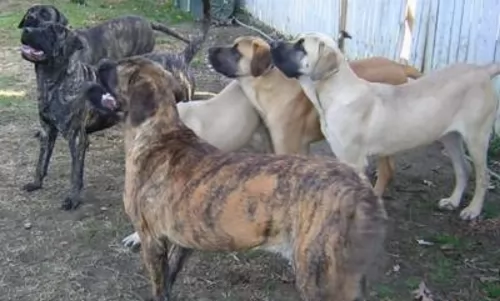 As an average shedder, the smooth, shorthaired coat is easy to groom, and a good brush twice a week will be adequate.
As an average shedder, the smooth, shorthaired coat is easy to groom, and a good brush twice a week will be adequate.
The Giant Maso Mastiff has floppy ears and therefore these should be checked for ear infections. Wax build up and dirt will need to be checked and cleaned.
His nails will need to be clipped, especially if they don’t wear down on their own and his teeth will need to be cleaned 2 or 3x a week to avoid dental disease.
With a large dog breed puppy such as the Giant Maso Mastiff, rapid growth is a risk factor for developing joint and bone conditions. The growth period can last till 12 months and puppies of large breeds should actually have their caloric intake adjusted during this growth period.
It is important to ensure that your puppy grows at a slow, steady rate. If you are feeding dog food from the commercially manufactured range, if you aren’t sure, speak to your vet about large breed dog foods. You want to be sure that this gentle giant of yours receives the best dog food there is, whether commercial branded dog food or your own home-made food. Good nutrition is imperative for the health of your pet.